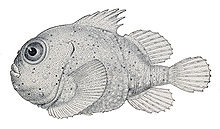- Lumpsucker
-
Lumpsuckers 
Smooth lumpsucker, Aptocyclus ventricosus, inflated in a defensive response. Scientific classification Kingdom: Animalia Phylum: Chordata Class: Actinopterygii Order: Scorpaeniformes Family: Cyclopteridae Genera Aptocyclus
Cyclopsis
Cyclopteropsis
Cyclopterus
Eumicrotremus
Lethotremus
See text for species.Lumpsuckers or lumpfish are mostly small scorpaeniform marine fish of the family Cyclopteridae. They are found in the cold waters of the Arctic, North Atlantic, and North Pacific oceans. The greatest number of species are found in the North Pacific.
The roe of Cyclopterus lumpus, known as the stenbider (literally "stone biter") in Danish or stenbit in Swedish, is used extensively in Scandinavian cuisine. The roe is also used as an affordable alternative to the caviar produced by sturgeons.
The family name Cyclopteridae derives from the Greek words κύκλος (kyklos), meaning "circle", and πτέρυξ (pteryx), meaning "wing" or "fin", in reference to the circle-shaped pectoral fins of most of the fish that comprise this family.
Contents
Physical description
Lumpsuckers are named appropriately enough; their portly bodies are nearly spherical with generally drab coloration and lithic patterns. The "sucker" part refers to the fish's modified pelvic fins, which have evolved into adhesive discs (located ventrally, behind the pectoral fins); the fish use these discs to adhere to the substrate. Many species have bony, wart-like tubercles adorning the head and body; these are important taxonomic features of the family.
The simple, rounded fins are small with the exception of the broad, fan-like pectorals, which actually extend ventrally. The first of the two dorsal fins is spinous, with 4-8 spines; in some species, this fin is completely overgrown with skin and therefore not visible. While the lateral line in lumpsuckers is otherwise reduced or absent, it is well developed in the head; some species even have tubular, whisker-like external projections of the opercular canal, which is a part of the cranial lateral line system.
The relatively small mouths of lumpsuckers are lined with narrow rows of small conical teeth. The gas bladder is absent. In terms of length, lumpsuckers range in size from two centimetres in the case of Lethotremus awae up to 50 centimetres in the case of the common lumpsucker Cyclopterus lumpus.
Habitat and diet
As their appearance might suggest, lumpsuckers are poor swimmers. Most species are benthic; that is, they spend most of their time on or near the bottom. The fish are found on rocky or muddy substrates, where their coloration allows for effective camouflage. Members of the family are found primarily on the continental shelf or slope, at depths from 100-1,700 metres. Some of the deeper-living species are however pelagic, remaining some distance above the ocean floor.
Benthic species feed on sessile invertebrates such as polychaete worms, crustaceans and mollusks. Pelagic species target prey they are capable of overtaking, namely slow-moving jellyfish and ctenophores.
Behaviour and reproduction
Lumpsuckers are a poorly studied group, with little known of their behaviour and biology. At least some species are known to travel great distances in order to spawn in shallow, intertidal waters (from December to June in the smooth lumpsucker); this may well be true of all species. Males are also known to guard the brood of spherical eggs.
One of the peculiarities of Lumpsuckers neural system is that they lack Mauthner cell neurons in their hindbrain, while these cells are present in virtually all other teleost fish. Nevertheless, the lumpsuckers do have a C-startle response, which is apparently mediated by other hindbrain cells[1].
Hatchlings have well-developed pectoral fins and adhesive pelvic discs, which the fish use to cling to rocks in shallow water. Young fish remain in shallow, warmer water until fully developed. Pacific cod and sablefish are known predators of lumpsuckers.
Species
Balloon lumpsucker in an aquarium.
There are 27 species in 6 genera:
- Genus Aptocyclus
- Smooth lumpsucker, Aptocyclus ventricosus (Pallas, 1769).
- Genus Cyclopsis
- Cyclopsis tentacularis Popov, 1930.
- Genus Cyclopteropsis
- Cyclopteropsis bergi Popov, 1929.
- Cyclopteropsis brashnikowi (Schmidt, 1904).
- Bumpy lumpsucker, Cyclopteropsis inarmatus Mednikov & Prokhorov, 1956.
- Smooth lumpfish, Cyclopteropsis jordani Soldatov, 1929.
- Cyclopteropsis lindbergi Soldatov, 1930.
- Arctic lumpsucker, Cyclopteropsis mcalpini (Fowler, 1914).
- Cyclopteropsis popovi Soldatov, 1929.
- Genus Cyclopterus
- Lumpsucker, Cyclopterus lumpus Linnaeus, 1758.
- Genus Eumicrotremus
- Pimpled lumpsucker, Eumicrotremus andriashevi Perminov, 1936.
- Eumicrotremus asperrimus (Tanaka, 1912).
- Eumicrotremus barbatus (Lindberg & Legeza, 1955).
- Leatherfin lumpsucker, Eumicrotremus derjugini Popov, 1926.
- Eumicrotremus fedorovi Mandrytsa, 1991.
- Eumicrotremus gyrinops (Garman, 1892).
- Pacific spiny lumpsucker, Eumicrotremus orbis (Günther, 1861).
- Eumicrotremus pacificus Schmidt, 1904.
- Toad lumpsucker, Eumicrotremus phrynoides Gilbert & Burke, 1912.
- Eumicrotremus schmidti Lindberg & Legeza, 1955.
- Eumicrotremus soldatovi Popov, 1930.
- Atlantic spiny lumpsucker, Eumicrotremus spinosus (Fabricius, 1776).
- Eumicrotremus taranetzi Perminov, 1936.
- Eumicrotremus tartaricus Lindberg & Legeza, 1955.
- Eumicrotremus terraenovae Myers & Böhlke, 1950.
- Genus Lethotremus
- Lethotremus awae Jordan & Snyder, 1902.
- Lethotremus muticus Gilbert, 1896
Note: Eumicrotremus eggvinii (Koefoed, 1956) has been shown to be the male of the E. spinosus species.[2][3]See also
References
- ^ Hale ME (October 2000). "Startle responses of fish without Mauthner neurons: escape behavior of the lumpfish (Cyclopterus lumpus)". Biol. Bull. 199 (2): 180–2. PMID 11081724.
- ^ "Taxonomy needs DNA, and quick, simple ways to analyze it". The Barcode Blog. Rockefeller University. January 12, 2008. http://phe.rockefeller.edu/barcode/blog/2008/01/12/taxonomy-needs-dna-and-quick-simple-ways-to-analyze-it/.
- ^ Byrkjedal, I., Rees, D.J. and Willassen, E. (2007) "Lumping lumpsuckers: molecular and morphological insights into the taxonomic status of Eumicrotremus spinosus (Fabricius, 1776) and Eumicrotremus eggvinii Koefoed, 1956 (Teleostei: Cyclopteridae), Journal of Fish Biology, 71 (sa), p. 111–131, doi:10.1111/j.1095-8649.2007.01550.x
Categories:- Cyclopteridae
- Genus Aptocyclus
Wikimedia Foundation. 2010.






